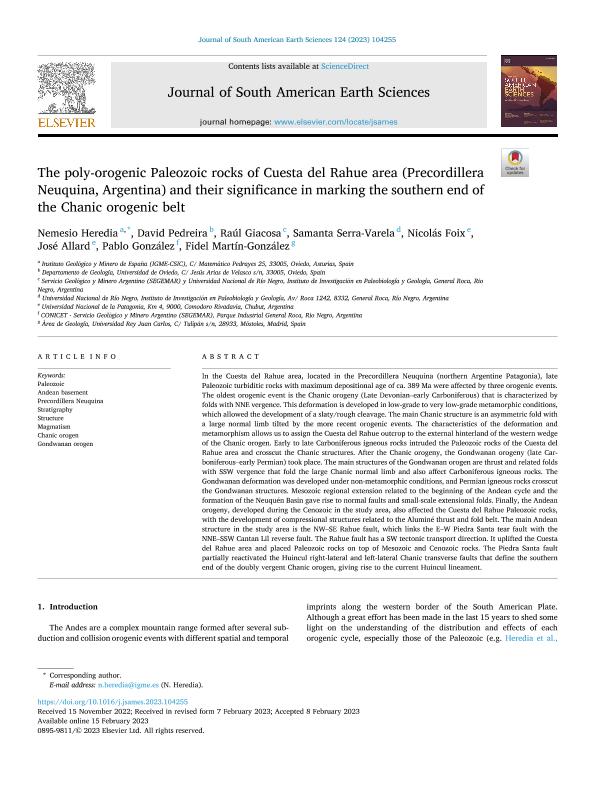Mostrar el registro sencillo del ítem
dc.contributor.author
Heredia, Nemesio

dc.contributor.author
Pedreira, David
dc.contributor.author
Giacosa, Raul Eduardo

dc.contributor.author
Serra Varela, Samanta

dc.contributor.author
Foix, Nicolas

dc.contributor.author
Allard, José
dc.contributor.author
González, Pablo
dc.contributor.author
Martín González, Fidel
dc.date.available
2024-01-03T19:09:09Z
dc.date.issued
2023-04
dc.identifier.citation
Heredia, Nemesio; Pedreira, David; Giacosa, Raul Eduardo; Serra Varela, Samanta; Foix, Nicolas; et al.; The poly-orogenic Paleozoic rocks of Cuesta del Rahue area (Precordillera Neuquina, Argentina) and their significance in marking the southern end of the Chanic orogenic belt; Pergamon-Elsevier Science Ltd; Journal of South American Earth Sciences; 124; 4-2023; 1-22
dc.identifier.issn
0895-9811
dc.identifier.uri
http://hdl.handle.net/11336/222340
dc.description.abstract
In the Cuesta del Rahue area, located in the Precordillera Neuquina (northern Argentine Patagonia), late Paleozoic turbiditic rocks with maximum depositional age of ca. 389 Ma were affected by three orogenic events. The oldest orogenic event is the Chanic orogeny (Late Devonian–early Carboniferous) that is characterized by folds with NNE vergence. This deformation is developed in low-grade to very low-grade metamorphic conditions, which allowed the development of a slaty/rough cleavage. The main Chanic structure is an asymmetric fold with a large normal limb tilted by the more recent orogenic events. The characteristics of the deformation and metamorphism allows us to assign the Cuesta del Rahue outcrop to the external hinterland of the western wedge of the Chanic orogen. Early to late Carboniferous igneous rocks intruded the Paleozoic rocks of the Cuesta del Rahue area and crosscut the Chanic structures. After the Chanic orogeny, the Gondwanan orogeny (late Carboniferous–early Permian) took place. The main structures of the Gondwanan orogen are thrust and related folds with SSW vergence that fold the large Chanic normal limb and also affect Carboniferous igneous rocks. The Gondwanan deformation was developed under non-metamorphic conditions, and Permian igneous rocks crosscut the Gondwanan structures. Mesozoic regional extension related to the beginning of the Andean cycle and the formation of the Neuquén Basin gave rise to normal faults and small-scale extensional folds. Finally, the Andean orogeny, developed during the Cenozoic in the study area, also affected the Cuesta del Rahue Paleozoic rocks, with the development of compressional structures related to the Aluminé thrust and fold belt. The main Andean structure in the study area is the NW–SE Rahue fault, which links the E–W Piedra Santa tear fault with the NNE–SSW Cantan Lil reverse fault. The Rahue fault has a SW tectonic transport direction. It uplifted the Cuesta del Rahue area and placed Paleozoic rocks on top of Mesozoic and Cenozoic rocks. The Piedra Santa fault partially reactivated the Huincul right-lateral and left-lateral Chanic transverse faults that define the southern end of the doubly vergent Chanic orogen, giving rise to the current Huincul lineament.
dc.format
application/pdf
dc.language.iso
eng
dc.publisher
Pergamon-Elsevier Science Ltd

dc.rights
info:eu-repo/semantics/openAccess
dc.rights.uri
https://creativecommons.org/licenses/by/2.5/ar/
dc.subject
ANDEAN BASEMENT
dc.subject
CHANIC OROGEN
dc.subject
GONDWANAN OROGEN
dc.subject
MAGMATISM
dc.subject
PALEOZOIC
dc.subject
PRECORDILLERA NEUQUINA
dc.subject
STRATIGRAPHY
dc.subject
STRUCTURE
dc.subject.classification
Geología

dc.subject.classification
Ciencias de la Tierra y relacionadas con el Medio Ambiente

dc.subject.classification
CIENCIAS NATURALES Y EXACTAS

dc.title
The poly-orogenic Paleozoic rocks of Cuesta del Rahue area (Precordillera Neuquina, Argentina) and their significance in marking the southern end of the Chanic orogenic belt
dc.type
info:eu-repo/semantics/article
dc.type
info:ar-repo/semantics/artículo
dc.type
info:eu-repo/semantics/publishedVersion
dc.date.updated
2023-12-19T12:12:20Z
dc.journal.volume
124
dc.journal.pagination
1-22
dc.journal.pais
Estados Unidos

dc.description.fil
Fil: Heredia, Nemesio. Instituto Geológico y Minero de España; España
dc.description.fil
Fil: Pedreira, David. Universidad de Oviedo; España
dc.description.fil
Fil: Giacosa, Raul Eduardo. Secretaría de Industria y Minería. Servicio Geológico Minero Argentino; Argentina. Universidad Nacional de Río Negro. Sede Alto Valle. Instituto de Investigaciones en Paleobiología y Geología; Argentina
dc.description.fil
Fil: Serra Varela, Samanta. Consejo Nacional de Investigaciones Científicas y Técnicas. Centro Científico Tecnológico Conicet - Patagonia Norte. Instituto de Investigación en Paleobiología y Geología; Argentina
dc.description.fil
Fil: Foix, Nicolas. Consejo Nacional de Investigaciones Científicas y Técnicas; Argentina. Universidad Nacional de la Patagonia "San Juan Bosco"; Argentina
dc.description.fil
Fil: Allard, José. Universidad Nacional de la Patagonia "San Juan Bosco"; Argentina
dc.description.fil
Fil: González, Pablo. Secretaría de Industria y Minería. Servicio Geológico Minero Argentino; Argentina
dc.description.fil
Fil: Martín González, Fidel. Universidad Rey Juan Carlos; España
dc.journal.title
Journal of South American Earth Sciences

dc.relation.alternativeid
info:eu-repo/semantics/altIdentifier/url/https://linkinghub.elsevier.com/retrieve/pii/S0895981123000664
dc.relation.alternativeid
info:eu-repo/semantics/altIdentifier/doi/https://doi.org/10.1016/j.jsames.2023.104255
Archivos asociados
